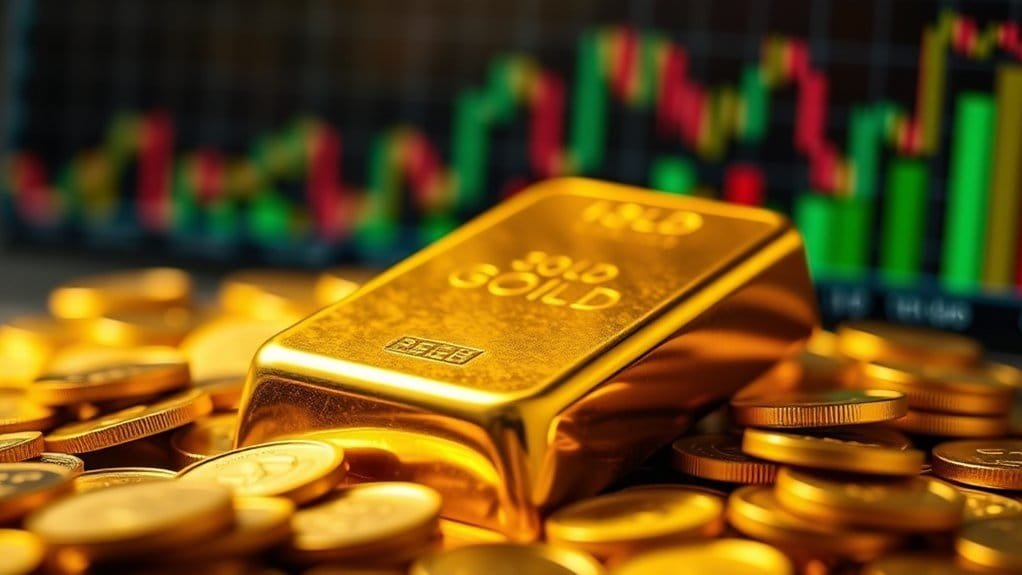Bank of America initially offered a gold price prediction of hitting $4,000. Now, the 2025 forecast sits at $3,063. A slight downgrade, eh? 2026? $3,350. Geopolitical tensions and trade policies are major drivers. A China deal? Bad for gold. Economic growth? Also bad. Major events, like, say, World War III, needed for a real surge. Silver might outperform gold in 2025. Wild swings ahead? Perhaps. More awaits.

Even if you’re not Nostradamus, projections about gold prices in 2025 are all the rage. Bank of America (BofA) is making waves with its predictions, some of which are genuinely wild. At one point, they suggested gold could hit $4,000 per ounce. However, their more recent forecasts are slightly more tempered: $3,063 in 2025 and $3,350 in 2026. Hey, I guess reality sets in eventually.
The big question is, what drives these numbers? Initially: U.S. trade policies. Are they predictable? Nope. Next: geopolitical tensions. Think Russia and Ukraine. A stable global trade system obviously matters, unless you’re looking for chaos—financial chaos. Any trade agreements that enhance the economy might ironically reduce gold demand. The China deal? It chilled things out, sadly (or happily), for gold bugs. BofA’s analysis plays a role in this.
Gold is often considered a safe investment when things are hairy. The recent supposed peak at $3,500 might be tough to beat, and would probably require something catastrophic in the world. BofA is still long-term bullish, whatever that means. Other brokerages, like Goldman Sachs, are also raising their forecasts. Key Point: hitting $4,000 depends on a lot of things going bonkers. One example is Goldman Sachs recently increased their end-2025 gold price forecast to $3,300.
Historically, gold prices surge during crises. The current forecasts reflect an increase from previous years. Remember when BofA gave gold two years to hit $3,500? It happened faster than expected. Economic uncertainty keeps gold shining. Predictions of $4,000? A significant leap. Investor skepticism is rising amidst volatile price movements.
Now, silver. BofA thinks it will outperform gold in 2025. Silver can swing wildly, all right. That means potential for prices to rise. Industrial demand and economic conditions. Oh, and pay attention to the relationship between gold and silver. That affects market trends. This affects investment strategies, but so does a good horoscope.
Short-term, watch out if geopolitical tensions don’t rise. A China deal calms us all down. Economic growth? Hurts gold. We need major events to make gold prices soar, really. That sums it up. BofA is bullish long-term. Gold is supposedly safe. Geopolitical tensions? Economic jitters? Those are the real drivers. And gold market trends hinge upon them.
Frequently Asked Questions
What Factors Could Derail Bank of America’s Prediction?
Several factors could torpedo that dreamy $4,000 gold prediction.
Interest rate hikes, for one, might actually make bonds look appealing again.
Economic downturns? Yeah, those could curb general investment, gold included.
Stronger than expected dollar could really rain on that parade.
Changes in investor sentiment, more supply, less demand – bam, prediction busted.
Honestly, betting the farm on any single forecast? Risky business.
How Does Gold Perform During Deflationary Periods?
So, how does gold do when prices fall? Deflation impacts it notably. Historically, gold prices might drop.
Seriously? But, gold’s purchasing power tends to rise. Gold resilience is definitely shown.
During deflationary times from 1814-1830 prices fell by 50%, but that purchasing power? It doubled!
Similar story in other deflationary periods. Gold weathers the storm; a worthwhile investment (historically, at least).
What Are Alternative Investments to Gold Right Now?
Alternatives to gold exist, sure, but some are questionable.
Real estate? Tangible, yet illiquid. Plus, being a landlord? A nightmare.
Then there’s cryptocurrency. Volatile. Risky. A digital casino, basically.
Commodities offer some hedging. Forget private equity unless one likes lock-up periods that feel like forever.
Digital assets? Still speculative.
Diversification matters. The goal is surpassing gold, maybe. Good luck though, because markets? Unpredictable.
How Does Geopolitical Instability Affect Gold Prices?
Geopolitical instability? Big deal for gold.
When the world’s a mess, gold glitters. Geopolitical tensions, like squabbling countries and military saber-rattling, crank up the fear. That drives investors to gold, a classic safe haven.
Expect market volatility to surge. Higher demand equals higher prices. It’s simple.
War, trade wars, endless drama – gold loves it. Until some other shiny object distracts humanity, expect this trend to continue.
What Are the Tax Implications of Investing in Gold?
Gold investments? Taxes, taxes, taxes.
Physical gold is deemed a collectible. Capital gains are taxed higher. Long-term? Up to 28%. Short-term? Ordinary income. Nice!
Mining stocks get standard rates. Cost basis matters. Factor in storage, fees, the works. Less tax, see?
Keep records, seriously. Form 8949, Schedule D—learn them.
Gold IRAs? Rules galore. Early withdrawal? Ouch.
Investment strategies need tax planning, or you’ll regret it. No free lunch, ever.
